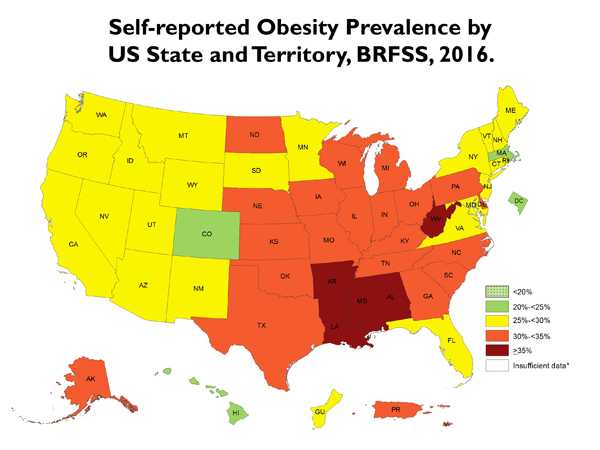New CDC Data Shows US Adults Still Struggling with Obesity
Media Advisory
For Immediate Release: Thursday, August 31, 2017
Contact: Media Relations
(404) 639-3286
What
The Centers for Disease Control and Prevention released 2016 state- and territory-specific data on adult obesity using self-reported information from the Behavioral Risk Factor Surveillance System (BRFSS).
The 2016 maps show that the proportion of adults with obesity in the United States remains high.
When
Thursday, August 31, 2017
Where
The maps are available at https://www.cdc.gov/obesity/data/prevalence-maps.html.
Key findings:
- All 50 states had more than 1 in 5 adults (20 percent) with obesity.
- Estimates vary across states, ranging from 22.3 percent in Colorado to 37.7 percent in West Virginia.
- The South had the highest prevalence of obesity (32.0 percent), followed by the Midwest (31.4 percent), the Northeast (26.9 percent), and the West (26.0 percent).
- Five states (Alabama, Arkansas, Louisiana, Mississippi, and West Virginia) now have more than 35 percent of adults with obesity.
- Adults with more education were less likely to report being obese. Adults without a high school education had the highest self-reported obesity (35.5 percent), followed by high school graduates (32.3 percent), adults with some college (31 percent), and college graduates (22.2 percent).
According to combined data for 2014-2016:
- Self-reported obesity for Non-Hispanic blacks was 38.3 percent.
- Self-reported obesity for Hispanics was 32.5 percent.
- Self-reported obesity for non-Hispanic whites was 28.1 percent.
Why
Millions of American adults are obese, putting them at risk for serious chronic diseases and health conditions. These include:
- Type 2 diabetes.
- Cardiovascular disease.
- Stroke.
- Certain cancers,
- Poorer mental health.
- Infertility and problems with pregnancy.
Obesity negatively affects worker productivity, healthcare costs, and the ability to serve in the military.
How
Preventing and reducing obesity in the United States will require action by many parts of society. State and community leaders, employers, government agencies, healthcare providers, and many others can help make it easier for adults and their families to move more and eat healthier to reduce the risk of obesity.
Find out more at https://www.cdc.gov/obesity/strategies/index.htmls.
- Page last reviewed: August 31, 2017
- Page last updated: August 31, 2017
- Content source:



 ShareCompartir
ShareCompartir
